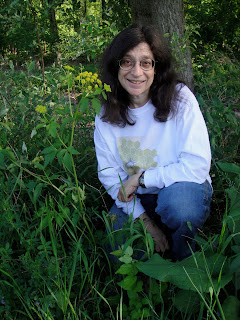With bee populations on the decline, the U of I embarks on a census of sorts

(UPDATED: 5/11/10) What's the buzz?
The University of Illinois is trying to find out -- as part of a program called "BeeSpotter" that's getting a handle on the numbers and locations of bumble bees and honey bees across the state.
It's an important endeavor given the alarming -- and perplexing -- decline in recent years of both types of bees, which are great pollinators of crops and other plants.
While the U.S. Census Bureau is relying on questionnaires and door-knockers to count every man, woman and child, the U of I is enlisting "citizen scientists," as well as the Internet, to chart bees in Illinois.
Among the aims, "establish a much-needed baseline for monitoring population," and "enhance public appreciation of pollination as an ecosystem service," according to the BeeSpotter web site.
Here's how the program works:
Regular folks are encouraged to take photos of bees in their neck of the woods, and upload the pictures onto the BeeSpotter site.
Someone from BeeSpotter then notes the type of bee, as well as location and date.
The program, with 725 participants so far, already has provided intriguing information.

"Less than a year after our site went up, a beespotter near Peoria uploaded two absolutely unambiguous photos of a bee called the rusty-patched bumble bee, Bombus affinis, which was thought to be extinct in that part of state," said May Berenbaum (pictured right.) She's the U of I entomology professor who conceived the BeeSpotter program, launched in fall 2007 at the Urbana-Champaign campus.
Fellow professor Sydney Cameron added: "Up until 50 years ago, there were all sorts of species in the northern part of Illinois. But now, we see a reduction in the number of species."
The Chicago Honey Co-op, a bee farm on Chicago's West Side (shown below), lost about half of its hives last year, according to Michael S. Thompson, farm manager and one of the co-op's founders.

The farm sent dead bees for testing. However, what happened is "a complete mystery," Thompson said. "Honestly, we don't know. It could be location, it could be genetics, it could be something else completely different."
The die-off of honey bees across the country likewise is something of a mystery, but a combination of factors could be to blame.
A government report from earlier this year mentions pesticides, viruses, infections from mites, even contaminated water supplies as possible culprits.
Meanwhile, another hope of the BeeSpotter initiative is that the public image of bees is polished up a bit, so they're not simply seen as a nuisance with a stinger.
Cindy Duda, environmental education specialist with the U.S. Fish & Wildlife Service office in Illinois, said: "The greater challenge is reaching homeowners who have been convinced that every insect is a bad insect and they must use pesticides to kill or control everything."
By Michaela Ehimika, for ChicagoWildlifeNews.com
Contact: [email protected]
Overview: There are more than 4,000 species of bees in the United States, with bumble bees and honey bees the most conspicuous kinds. They are different than wasps although can be similar in coloring and behavior. Hornets and yellow jackets are among the more noticeable wasps. Following are general characteristics.
BEES: Hairier and sometimes more rounded than wasps, subsisting off nectar and pollen. Bees are "premier pollinators."
+Honey bees: Not native to North America. Major pollinators of crops and other plants. Die off after stinging somebody. Produce honey. Often housed in man-made hives. In the wild, often found in tree holes. Smaller than bumble bees. Colonies generally survive the winter, and can include 30,000 to 40,000 "workers." (There's only one honey bee species in U.S.)
+Bumble bees: Larger than honey bees. Make honey, but so little it's not harvested by humans. Colony typically has 200 to 400 workers, who die off during winter. Often nest in ground, in old rodent burrows. They'll sting, but usually only near hive, or if feeling threatened. They're loud buzzers. (There are 50 or so species in the U.S., 11 of which are in Illinois.)
WASPS: Often appear to have narrow waste-lines, with smoother, shinier exteriors. Predatory, eating other insects, or scavenging. Sometimes aggressive picnic pests. Pollinating is less their thing. Can sting repeatedly without dying. Not honey makers. Colonies die over winter.
+Hornets: Usually responsible for those football-sized papery nests hanging from branches. Larger than yellow jackets.
+Yellow jackets: "Garbage hounds," often pests at picnics. Frequent stingers of people. Like to nest in ground.
Sources: University of Illinois, Xerces Society for Invertebrate Conservation, other web research
Photos: Top photo shows rusty patched bumble bee, snapped by Downstate beespotter, courtesy of University of Illinois' BeeSpotter. Middle photo supplied by May Berenbaum. Photo of beehives courtesy of Chicago Honey Co-op.


0 comments: